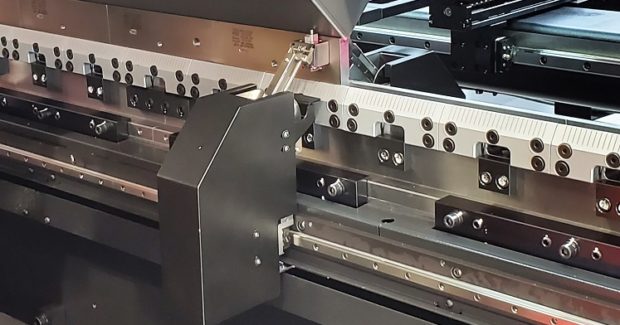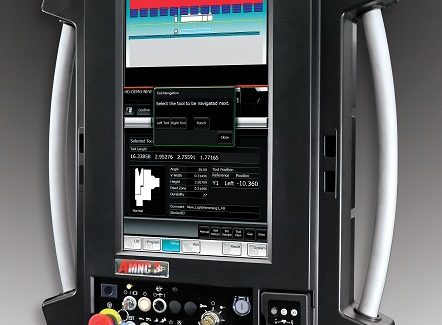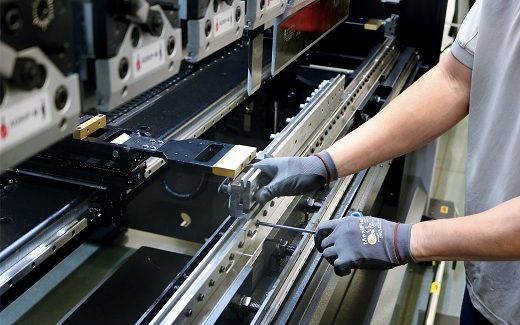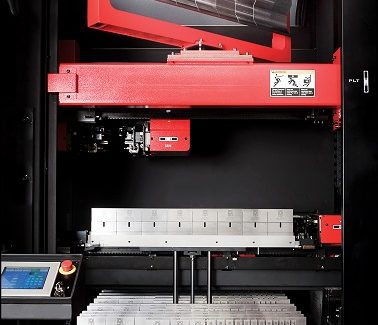Maintaining Optimal Bending Capacity Despite Labor Challenges
Key components for achieving maximum flexibility and cost-effective productivity.
Posted: December 17, 2021
METAL FORMING & FABRICATING
Submitted on behalf of AMADA AMERICA INC.
Fabricators need bending solutions that maximize efficiency and productivity while providing repeatable precision from operator to operator. These challenges are complicated further due to varying skill levels of press brake operators — especially in the face of labor shortages. Consequently, automated features are becoming essential components of standalone press brakes and bending systems alike to an ever-increasing degree.
In bending, the critical aspects that impact productivity the most are tool setup and programming times. If these issues aren’t resolved, high-mix, low-volume production becomes both problematic and costly. In addition, since reduced lead times and shrinking order sizes are often linked, fabricators must effectively solve these challenges to prosper.
OFFLINE PROGRAMMING
Maximizing machine utilization is one of the most effective ways to ensure higher levels of bending productivity. Offline bending software enables the verification of parts in a 3D environment. 3D simulation not only identifies problems before they can occur but also eliminates machine idle time. Once a part is automatically verified, tooling setup, bend sequence, and all of the corresponding 3D information can be stored in a single program on your company server. Then, data can quickly and easily be retrieved by the operator at the press brake control. Machine controls featuring an easy-to-use graphical interface significantly reduce the learning curve for operators that lack experience. In addition, machine controls featuring touch-screen simplicity accelerate workflow for both novice and experienced operators.
SETTING THE STAGE FOR MAXIMUM FLEXIBILITY AND PRODUCTIVITY
Inefficient tool setup is time-consuming and costly. Additionally, the negative impact on overall shop production increases with greater part complexity. With multiple bends requiring different tool sets, complex parts often require additional labor, setup, and teardown time. Stage bending provides efficiencies when forming complex parts or a series of different parts — all of which require multiple tooling setups. In such cases, multiple punches and die sets are staged next to each other across the bed length of the press brake. Maintaining consistent accuracy in the performance of stage bending requires a rigid machine frame design. Moreover, a hydraulic dynamic crowing system, built into the bed design of the brake, provides uncompromising precision. This feature compensates for any frame deflection during bending — ensuring consistent bends along the entire length of the machine.
PRECISE TOOLING PLACEMENT
Press brake controls that are equipped with Tool Navigation, provide a smart solution for resolving costly delays in your bending department. The operator simply clicks a button on the machine control. Then, the backgauge automatically moves into the correct position, thereby identifying the exact location for each tool setup. Tool Navigation enables operators to perform multiple tool setups with speed, simplicity, and accuracy regardless of their skill levels.
CONSISTENT ANGLE ACCURACY
Bend indicator technology is another way to ensure consistent bend angles even if your operator lacks experience. As the ram descends and bends the material, bend indicator sensors activate and compensate for any material springback. Productivity is greatly enhanced because corrections occur automatically without stopping production. Additional benefits of bend indicator technology include the elimination of test bends and scrap.
AUTOMATIC TOOL CHANGES
With a conventional press brake, switching to a rush job in the middle of production creates costly delays and causes bottlenecks that limit your shop’s overall capacity. Press brakes equipped with an Automatic Tool Changer (ATC) resolve these issues and precisely load even the most complex tooling setups in minutes. The ATC also combines outstanding versatility with enormous capacity by providing storage and precise tool management of punches and dies.
Because rush jobs can be verified offline, your operator simply loads the new part program. Then, the ATC performs error-free tool changes in a matter of minutes, even seconds — allowing your operator to quickly start bending. The ATC works with the press brake’s control to efficiently reposition tools that are used in common between different bend programs. Consequently, as soon as the rush job is complete, your operator can quickly return to production by selecting the previous part program and tool setup — resuming at the exact bend where they left off. In addition to the seamless introduction of rush jobs, quick tool setups achieved by the ATC can triple or quadruple the number of setups performed each day while eliminating costly delays associated with manual tool changes.
For additional information visit www.amada.com/America.







